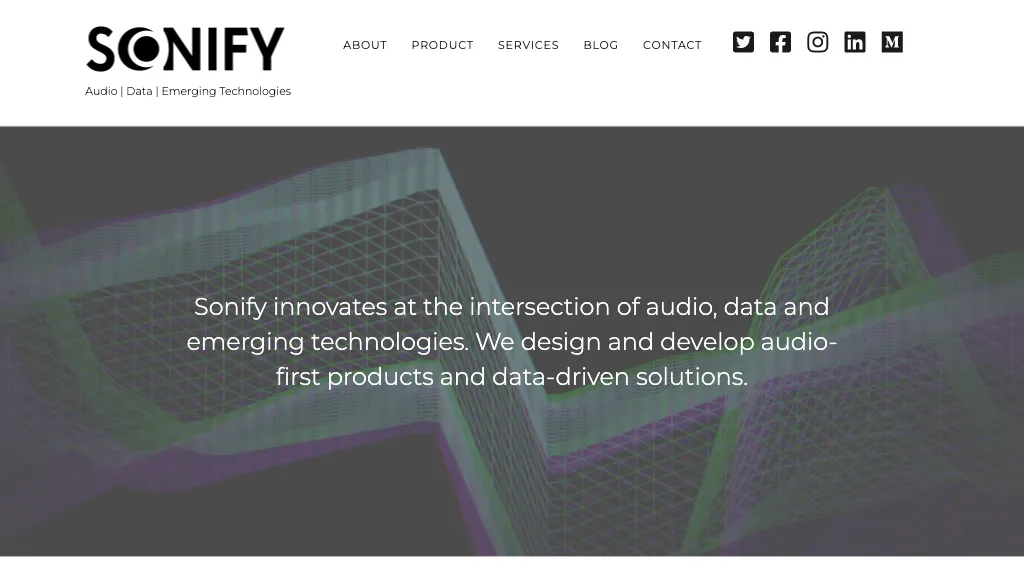What is Sonify?
Sonify is a state-of-the-art AI tool that amalgamates audio, data, and emerging technologies for the design and development of audio-driven products and solutions driven by data. This tool is specially recognized for some of its exceptional projects, which convert scientific data into music to make it accessible to the blind and visually impaired. It also enables users to transform any data into music without the requirement for coding. The Sonify team comprises experts in music production, data storytelling, and emerging media technologies.
Key Features & Benefits of Sonify
The Sonify platform facilitates several features and benefits targeted at diverse needs and users, making it popular among many. These are:
-
Scientific Data Sonification:
It takes scientific data as input and converts it into music. -
Bringing data to the blind and visually impaired:
With its services, Sonify creates an inclusive solution where data can be accessed by visually impaired people. -
Conversion of data into music:
Users convert data into musical compositions without requiring any type of programming knowledge.
The advantages in the use of Sonify are that there will be more comprehension in terms of data through audio, it becomes more accessible to visually handicapped users, and is user-friendly for translating processes involved into music form.
Use Cases and Applications of Sonify
The manifold uses of Sonify make it useful over a wide area of application:
-
Scientific Data Sonification:
Sonify can be used to convert researchers’ and scientists’ data into musical compositions for making complex data sets interesting yet understandable. -
Data Accessibility to the Visually Impaired:
Sonify is meant to enable an organization to develop data accessibility solutions for visually impaired people so that they can understand and interact with data. -
Turning data into music without coding:
Schools and amateurs use Sonify to explore the creation of data-driven music with no prior knowledge of programming.
Research and Academia, Accessibility Solutions, Emerging Media Technology Businesses-if there is a business that finds value in Sonify, case studies show how product managers, marketing professionals, data analysts, and audio engineers found the right place for Sonify in their work to enhance data interpretation and accessibility.
How to Use Sonify
Using Sonify is pretty easy, even for non-technical people. Just follow these steps:
- Create an account on the Sonify platform.
- Upload your dataset or input the data you want to transform.
- Choose the kind of musical transformation you need.
- Customize the output using Sonify’s intuitive interface.
- Generate and download your music file.
Most importantly, for full utilization, users are supposed to get comfortable with the various Sonify customization options and experiment with different data sets.
How Sonify Works
Advanced algorithms and models lie at the heart of the operation at Sonify. The data is analyzed, and with data parsing, pattern recognition, and audio synthesis, it is changed into several musical elements to come up with harmonious outputs of raw data. Normally, such a system should take the data input, process it via the provided algorithms, and spit out a musical composition representing that data.
Pros and Cons of Sonify
Like any other tool, Sonify has strengths and possible weaknesses:
Pros
- The audio representation of data will help in the better understanding of data.
- More accessible to visually impaired users.
- Usability: easy; one does not have to write a line of code.
Cons
- Having been restricted only to the audio presentation of data, which may not always apply to all kinds of data analysis.
- Starts off overwhelming for those who have never transformed data into audio.
Feedback from Users
This received generally very positive feedback among users, the majority appreciating the novelty of the tool and the ease of use.
Conclusion
Sonify is a landmark AI application that fills an important gap between data and music. Its ability to change complex data sets into musical compositions makes it very usable in the hands of researchers, educators, and accessibility advocates alike. The deficiencies it has are paid for by the advantages and unique features it possesses, making it well worth the investment for anyone who would seek to find new and creative ways to express data. This should become even more advanced in its capacities and wider in users with further development and updates.
Sonify FAQs
What all types of data does Sonify support for transformation?
Sonify has a long sweep in the data types it can support-scientific data, statistical data, and many more.
Does one need to know how to code to use Sonify?
No, Sonify has been made such that people without prior experience in coding can work on it with ease.
How does Sonify help visually impaired people?
Sonify offers the representation of data in audio form, thereby facilitating easy access to data by visually challenged persons.
Sonify Pricing Options
The pricing options can be found on the official website of the tool. They have designed these plans to accommodate a wide array of user needs and budgets.
Are tutorials available for a new user of this tool?
Yes, Sonify has made tutorials and guides available to help new users get started with the tool and maximize many of its features.










